Lago Pehoé with the Paine mountains in the background
Highlights
Did the Lago Grey Glacier Cruise, day hike to Mirador Base Las Torres, hiked to Mirador Cuernos and saw the Salto Grande and Cascada Paine waterfalls. Some helpful tips in planning your visit such as border crossing (if coming from Argentina), logistics, when to go , where to stay and what the weather was like.
Time of Visit: December 2023
Duration of Visit: Four Nights
Description
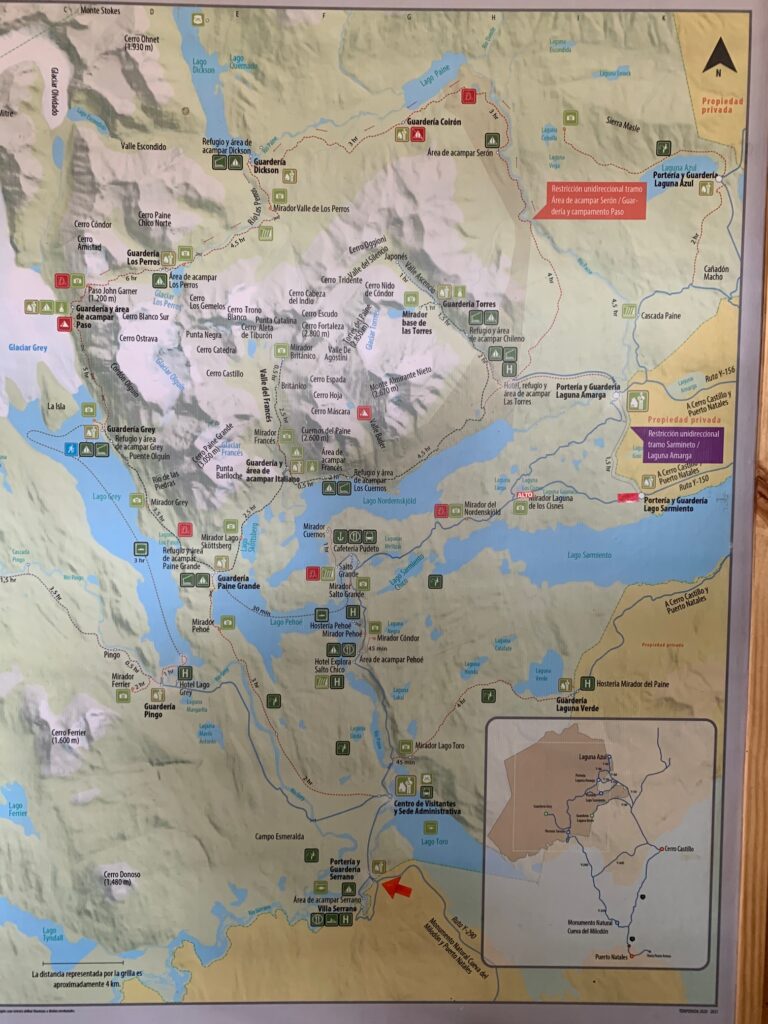

When most people hear the word Patagonia, more likely they start conjuring images of Torres del Paine National Park. Torres del Paine is one of the popular Patagonia destinations for good reasons. Its natural beauty is just breathtaking. The massive snow capped mountains contrast nicely with the blue sky and the occasional lenticular clouds. The blue and turquoise color lakes are just mesmerizing to look at. And there are still glaciers within the park, two of which can be prominently seen just by driving. These are Grey Glacier and Glacier Frances.
You will love Torres del Paine if you like Glacier National Park in Montana or have driven the Icefield Parkway between Banff and Jasper in Alberta, Canada.
Torres del Paine National Park is about 700 square miles so it is a large park. The park has a network of gravel roads that take visitors to some of the park’s breathtaking sceneries. But most of the beautiful areas in the park are in the backcountry where you have to hike in or do the multi-day hike such as the O and W treks (not covered in this blog). Scoring a permit and the necessary accommodations to do these multi-day hikes is not easy and requires advanced planning.
However, if you are content in seeing the iconic snow capped mountains (Cuernos del Paine) and glacial lakes (lagos Grey, Nordenskjöld and Pehoé) plastered all over the Internet, these can be seen from the park’s road system. Some are not as accessible such as the Mirador Base las Torres that require an all day and demanding hike.
The first part of this blog describes what we did in the four nights we explored the national park (our itinerary). The second half discusses useful information in planning your trip based on what we learned.
Our Itinerary
Day 1 – Drive to Rio Serrano and Afternoon Hike to an Unnamed Lake
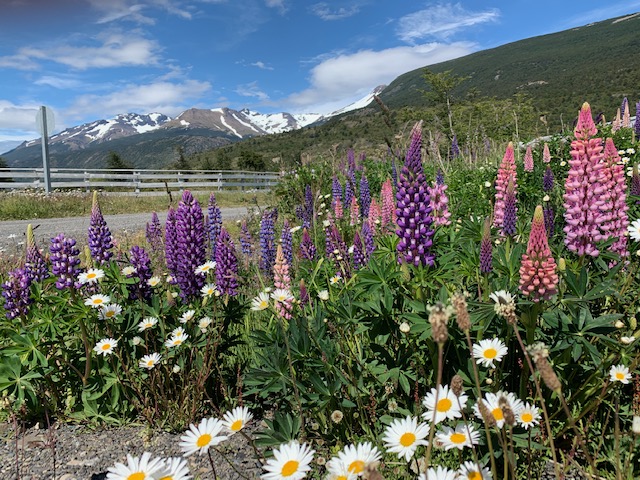

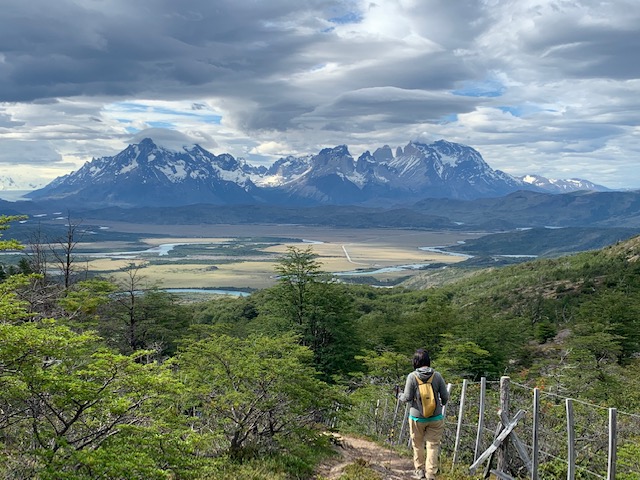

We drove from Puerto Natales, Chile to the south entrance of Torres del Paine. The distance is about 80 kms but took us around three hours to complete due to the frequent stops we had to make to take pictures. The road is paved until past the Cueva del Milodon where we encountered stretches of gravel road until reaching the community of Rio Serrano where we booked our accommodations. Purple and pink lupines and other colorful wildflowers were plentiful when we reached the Cruce Complejo (junction between roads Y-209 and Y-200).
With half of the day spent driving over to Rio Serrano, our host suggested hiking to an unnamed lake to the south. The trailhead was at the end of Y-290 before it transitioned to Patagonia Street as the entrance to the community of Rio Serrano. The hike took a total of about 2.5 hours. Though the destination lake was not particularly exciting, the view of the Rio Serrano valley and the Cuernos del Paine were outstanding.
Day 2 – Grey Glacier Cruise and Salto Grande Waterfall
Lago Grey and Grey Glacier Cruise




The Lago Grey and Grey Glacier cruise used about four hours of our day. We started late and missed the first cruise at 9AM (sailing is every three hours with the last being at 6 PM). It is best to take the earliest cruise or the latter cruises as some park trails close in the afternoon sometime around 3 or 4 PM. The actual sailing time lasts just under three hours.
The cruise company wants passengers to check in an hour before embarkation. The check in was at Hotel Lago Grey where we bought our cruise tickets. After checking-in, we drove to Guarderia Pingo. From Guarderia Pingo, it is around a 35 minute walk to the boat. It may take longer if you get sidetracked by taking pictures of icebergs in the water just like we did.
The boat stopped first at Guarderia Grey where it dropped off and picked-up passengers from the rifugio. Then it sailed towards the three toes of Grey Glacier. First was the east toe, then the south toe and the last was the west toe. The boat does not get close to the toes for safety purposes as calving may happen. It was furthest from the east toe but went nearer to the south and west toes. The boat did not drop anchor either. It just motored slowly alongside the toes. Better claim a side of the boat for good pictures and selfies.
Tip: It is not a cheap cruise. It cost us 90K CLP per person. El Calafate, Argentina also has glacier boat tours. The cost of the glacier boat tours in El Calafate were 1 ⁄ 3 the price of that of Grey Glacier but that was right around when the Argentine government devalued their currency. To us, the cruise was not worth the money.
Salto Grande Waterfall
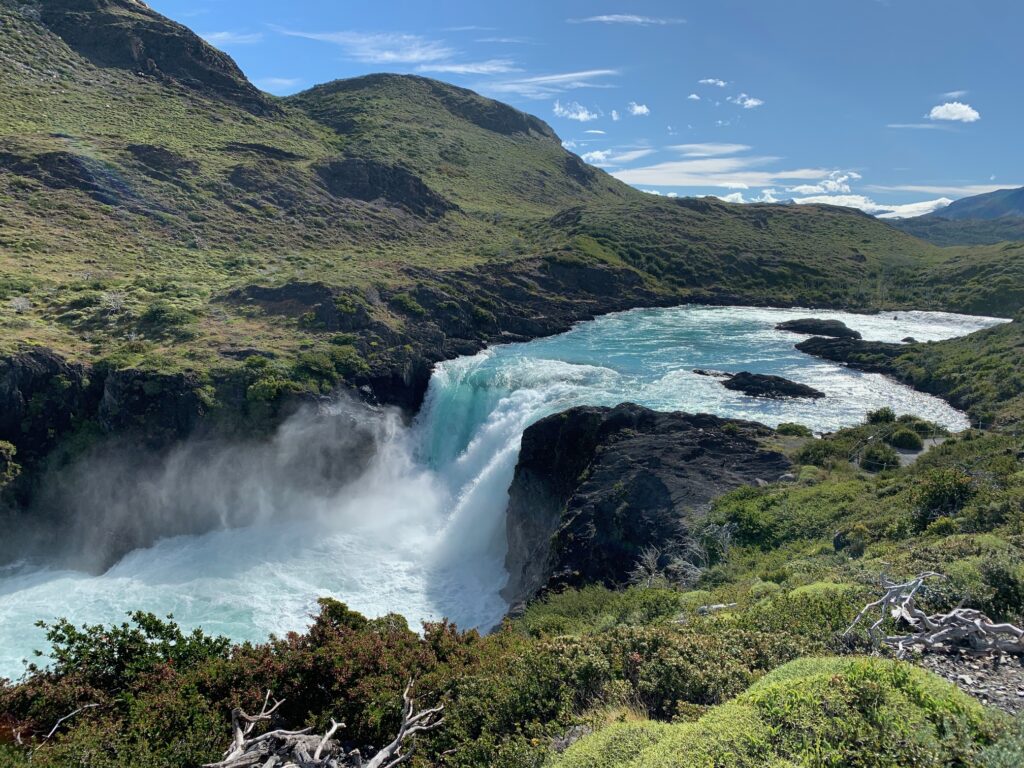

The Salto Grande waterfall connects Lago Nordenskjöld and Lago Pehoé. The waterfall can be viewed from Mirador Salto Grande or at an unnamed fenced viewing area just on top of the falls. The Mirador Salto Grande is off the roadside. Its view of the falls is across the lake so the falls look tiny.
The better view in our opinion is at the unnamed fenced viewing area. It is much closer albeit you will be viewing the falls from the side. The viewing area is only a short walk from the dirt Salto Grande parking lot past Cafeteria Pudeto.
Day 3 – Mirador Base de las Torres and Cascada Paine
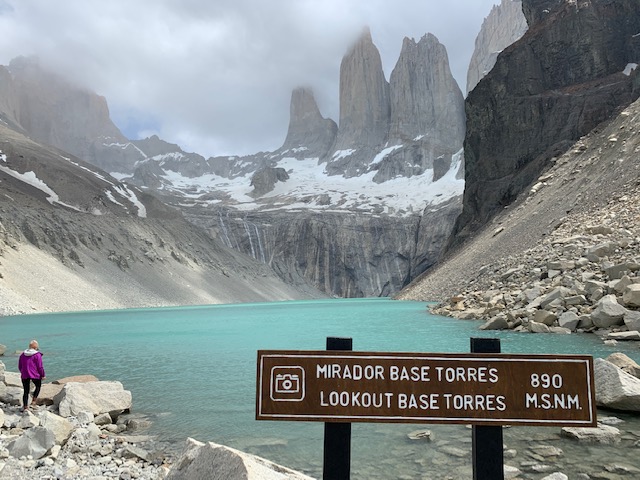

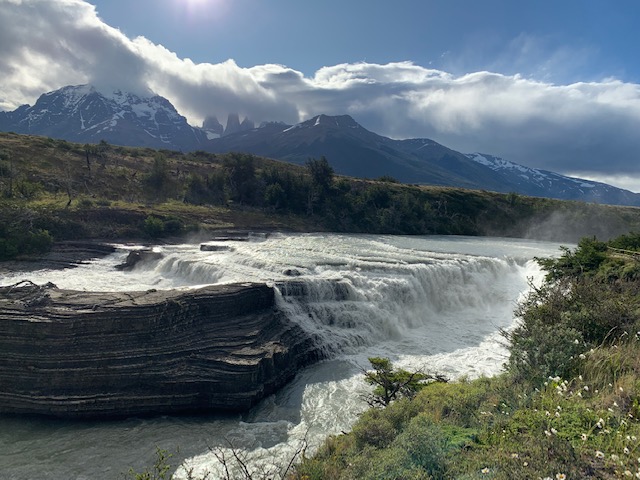

We combined these two attractions on the same day because it is located at the park’s northern part. Even though it ended up as a long day (8 AM to 8 PM), it was better than doing the 50 km drive from Rio Serrano twice. The hike to Mirador Base de las Torres is probably the most popular day hike in the park.
Cascada Paine is a huge waterfall located at the park’s northeast section. It is about a 10 minute drive from the Amarga entrance.
Day 4 – Hike Mirador Cuernos
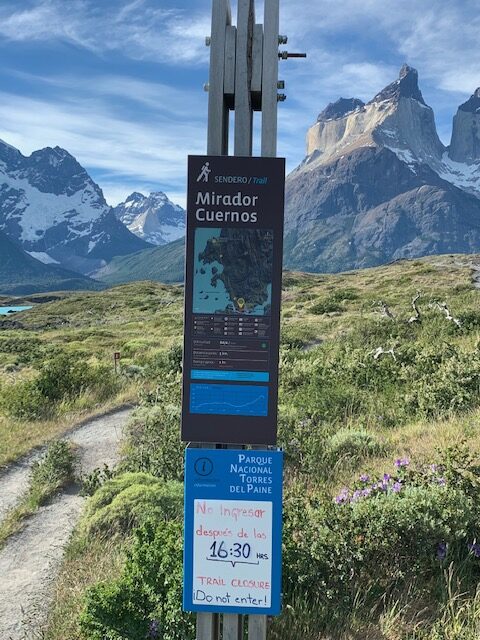

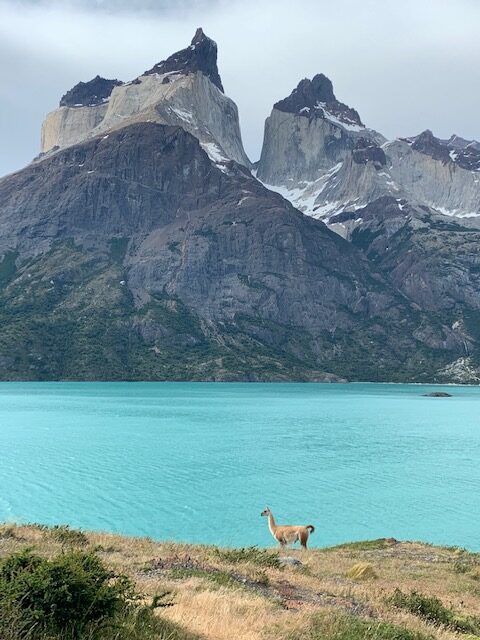

We took it easy in the morning and spent the entire afternoon at Mirador Cuernos. Mirador Cuernos is the one place in Torres del Paine that should not be missed. It is a short and easy hike at around three kilometers one way from the Salto Grande parking lot. It has minimal elevation difference. The mirador overlooks the Lago Nordernskjöld while facing Cerro Paine Grande and the Glacier Frances to the left and the Cuernos del Paine to the right.
The hike to Mirador Cuernos has a cutoff time of 4:30 PM, meaning visitors must be past the trail entrance by this time. We wanted to do this hike on Day 2 but were unable to make the cutoff time because we took the 12PM Lago Grey cruise.
Visitors are also required to leave the mirador by 6 PM.
Other Places to see
Mirador Condor
We did not do Mirador Condor as our legs were pretty much worn out from doing the Mirador Base de los Torres. It has an intimidating elevation gain as the destination is to the top of the mountain. A guide that we talked to said that it offers a panoramic view of the park.
Mirador Condor can be accessed from two trailheads. The official trailhead shown on the park map is just down the road from Hotel Explora Salto Chico. You should be able to see the trailhead sign if you keep your eyes on the right side of the road as you drive north. The park map shows it would take about 45 minutes to reach the mirador.
The other way to access the mirador is from Mirador Pehoé. There is no trailhead sign here, just a trail in the direction of the mountain. This is where we ran into the guide that was taking his guests to the mirador. The guide said it normally takes an hour to reach Mirador Condor from Mirador Pehoé.
Mirador Ferrier
We did not do this hike as the park ranger we talked to at the south entrance did not mention it when we asked her which hikes should we do. The trailhead is right behind the ranger station at Guarderia Pingo which is down the road from Hotel Lago Grey.
Laguna Amarga
Laguna Amarga is a small lake outside the park near the park entrance that bears the same name. This was recommended to us by our host which described the place as having a beautiful view with the Paine mountains in the background and lake in the foreground. He also added that it is a nice place to have lunch. We did not have enough time to visit this lake on Day 3.
Planning Your Torres Del Paine Trip
How Reach Torres del Paine
The jumping off point to get to Torres del Paine is the city of Puerto Natales. Torres del Paine is about 80 kilometers from Puerto Natales. However, Puerto Natales does not have an airport. There are two ways to reach Puerto Natales. The first way is to fly into the city of Punta Arenas, Chile and take a bus (or drive) to Puerta Natales. It takes about three hours to travel between the two cities by bus. The drive is slow going due to strong winds in this region of South America. We took Bus Sur to go from Puerto Natales to Punta Arenas and the cost was 10K CLP (Chilean Peso) in 2023.
The second way to reach Puerto Natales is to take a bus from El Calafate in Argentina. It takes about six hours including the stop at the border. Bus Sur also runs between El Calafate and Punta Arenas. There are other bus companies that make the same journey but they do not have a bus that runs every day of the week. We used Bus Sur because they have more departure times which means if a bus has a mechanical breakdown, we have a better chance of continuing with our journey with minimal delay. It cost us 25K ARS (Argentine Peso) per person in 2023.
Border Crossing
If you come from El Calafate, you will stop at the Argentine immigration office at the border to get your passport scanned which is equivalent to getting an exit stamp. Your passport will then be stamped at the Chilean immigration office. We waited for over an hour at the Chilean immigration office for the baggage to be scanned and sniffed by their dog. Just like the US, Chile does not allow meat, vegetables and cheese to be brought into the country.
We had to complete an electronic declaration form of what we were bringing into Chile. Bus Sur also hands out paper declaration forms to complete in case passengers are unable to complete the electronic version.
Best to complete the electronic declaration form at the El Calafate bus terminal while there is a cell signal. The cell service drops out once the bus leaves the city. Your next opportunity to have internet connection is at a gas station about two hours into the journey where there is Wifi. However, the bus only stops for about 15 to 20 minutes, enough for the drivers to take a meal break.
Logistics
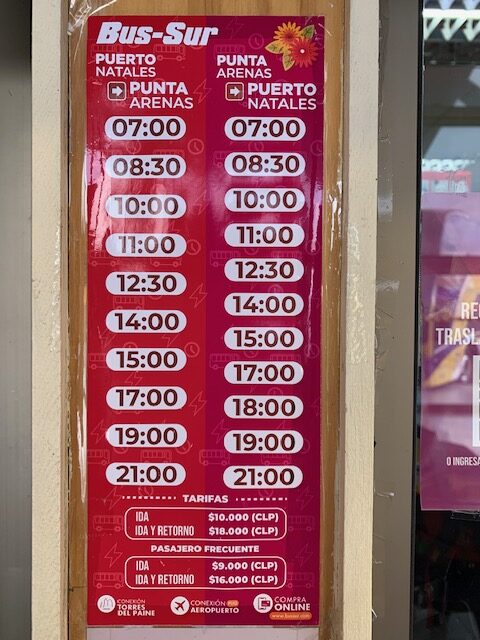

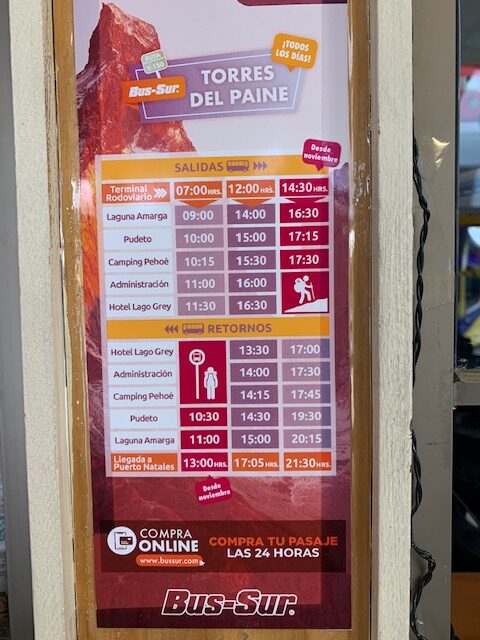

We visited Torres del Paine after El Calafate, Argentina and then moved on to Punta Arenas so we could catch a flight to Santiago, Chile. We spent two nights in Puerto Natales, one before going to Torres del Paine from El Calafate and the other before continuing to Punta Arenas. In hindsight, both nights at Puerto Natales could have been skipped though there would be no contingency if there was a bus or car breakdown,
At El Calafate, Bur Sur has an 8 AM bus that leaves for Puerto Natales. The bus would then arrive around 2PM in Punta Arenas. Most rental car agencies close at 5PM so there is sufficient time to get your rental car and drive to Torres del Paine. On the way to Punta Arena, the last bus that leaves Puerto Natales is 9PM. So even if you left Torres del Paine in the early afternoon, you would still be able to catch a Bus Sur headed to Punta Arena the same day.
We bought our bus tickets a couple of days prior to our desired departure. We Bus Sur with cash at El Calafate and with credit card at Punta Arenas
Puerto Natales is a small town. In our opinion, there is really not much to do or see in Punta Arenas that would require an overnight visit. Though Punta Arenas is a sprawling city, there was nothing much to do here as well. We spent three nights in Punta Arenas and ended up spending a day in their mall and the rest was just chilling in our accommodation.
It was very windy and chilly in the summer at both locations such that any outdoor venture was not that enjoyable. Internet service was also spotty.
Where to Stay


There are stays within the park as well as just outside the park. The stays within the park can be very pricey, especially at peak months (normally December, January and February). We stayed in the community of Rio Serrano which is by the Serrano River near the park’s south entrance. It was still pricey but less compared to the accommodations within the park.
If you truly want to stay in the park, Hosteria Pehoe probably has the best view of all the accommodations at sub astronomical prices. You have to cross a foot bridge over the lake to reach the hosteria. Then you have a magnificent view of the Paine mountains and Lago Pehoé.
The other advantage of staying within the park is that your driving time can be shorter as you explore the park. The roads within the park are graded dirt and gravel. Oftentimes it is a washboard with sharp turns so you cannot really drive fast or you may end up in a ditch. As a point of reference, it takes about an hour and a half to drive between the south entrance (Serrano) and the northeast entrance (Laguna Amarga) which is a distance of around 50 kilometers.
When to Go
The seasons are reversed in Torres del Paine compared to the US. Summer begins sometime in December and ends somewhere in March. Locals that we talked to said that this is the time that most visitors come to the park.
Weather
The temperature was all over the place during the four days we were there before Christmas. It is always cool to cold in the evenings and early mornings. Most people wear a down jacket to keep warm.
During the day, the temperature can change from cool to comfortable to warm to hot. It just depends on the time of day, how strong the wind is blowing, what activity you are doing and where you are in the park. For example, when we did the Mirador Base las Torres hike, we experienced being hot at the start, comfortable as we ascended with occasional wind and had to wear our jackets at the lake where it was much cooler when the clouds rolled in.
How Many Days
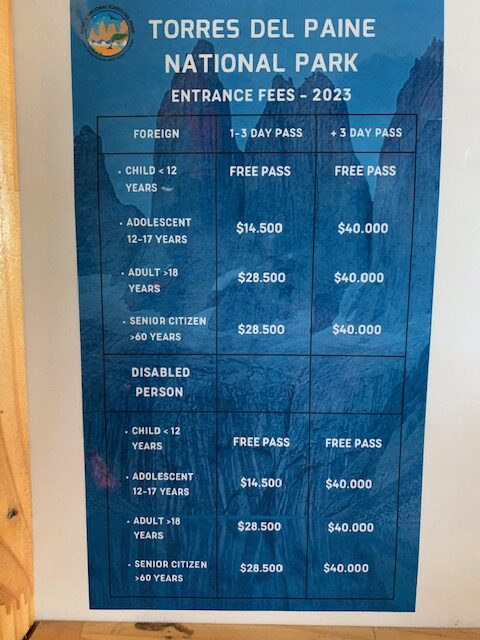

The number of days needed at the park depends on what you want to do. But in all likelihood, it will be dictated by the park pass. There are two kinds of park passes – a three day and a 10 day that cost more. To us, a three day park pass was enough to see the entire park without doing the multi day W and O treks. Most people complete the W trek in five days while the O trek within 10 days. The park accepts credit card payments.
Rental Vehicle
As mentioned earlier, a rental vehicle is a must to see most of the park that is accessible by road. Bus Sur has buses that leave for Torres del Paine from Punta Arenas. But the designated stops within the park are limited and would not be practical to walk from one stop to the other to be able to explore.
If you do decide to rent a vehicle, be forewarned that rental costs are on the expensive side (close to $100 per day). An ordinary car can handle the roads in Torres del Paine but a truck or SUV with larger tires would have a smoother ride over the unpaved road.
There are no gas stations within the park as well. So make sure you fill up the vehicle before leaving Punta Arenas. Our host in Rio Serrano did mention that there is a person that sells gas within the community.
Our rental car gave us the following tips when driving in Patagonia. First, firmly hold the door before opening. The strong winds may flung the door such that it could damage the hinges. Second, there are tour drivers that drive in the park without any care whatsoever. Their advice was to move to the side of the road as much as possible without ending up in the ditch and slow down to minimize the chances of a cracked windshield from the flying rocks. Last, if you do end up in the ditch, do not attempt to steer back on the road as it might flip the vehicle. Instead, come to a stop and then slowly get back on the road.
Summary
Torres del Paine for sure is on a lot of people’s bucket list. The majestic mountains with pointed peaks that look like horns contrast nicely with the blue sky and the jade and turquoise lakes. As an added bonus, glaciers are still present and can be viewed from roads within the park.
The park is about 80 kms from Puerto Natales where you can take a bus to go to the park or rent a vehicle. The park roads are graded dirt and gravel and have washboard sections. Best to rent a vehicle larger than an ordinary car so the ride does not feel as bumpy.
Three and 10 day park entry fees are available. A three day pass is sufficient to see most of the attractions if one is not doing the O or W trek. You will have more time to explore the park if you are not doing the Mirador Base de las Torres hike which takes at least eight hours to complete.
If the long grueling hike to Mirador Base de los Torres does not appeal to you, then going to Mirador Cuernos is equally beautiful. It is a day hike that cannot be missed. There are other day hikes in the park that are probably worth doing if time and energy permits. Doing the Lago Grey and Grey Glacier boat tour is another activity. But one thing would be a sure bet and that is the beauty of Torres del Paine will stay with you for a long time.
